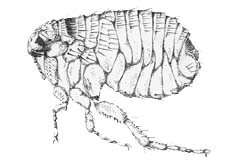Cat Flea Management
Monitoring your pet for infestations is the
most important part of cat flea control. By just simply
combing your pet for 5 minutes you can get an accurate and
precise estimate of flea populations. (Rust
2005)
If your pet has become
infested, elimination can be accomplished through using
insecticides such as shampoos, sprays, dips, foams, spot-ons,
collars, powders, and oral systemics.
When selecting an insecticide formulation you should be sure
take into account the several factors, such as the species and age of
the animal treated, the level of infestation, rate of potential reinfestation, thoroughness of environment treatment, and
insecticide resistance pattern of the flea population. (Rust
and Dryden 1997)
If you are looking
into products, the safest "on-pet" solutions to use are
botanicals or silica gels as flea collars have been found to, in
fact, be ineffective. After application of products such
as dusts, shampoos, or dips, the animal may be free from fleas,
but once it is put back into an infested area it is very likely
that it will once again become populated. Due to this it
is essential to treat the home, yard, and the animal
simultaneously.
For yard treatment, insect growth regulators (methoprene,
hydroprene, and pyriporxyfen) are suggested due to their
effectiveness and safety to humans and pets. For indoor
treatments surface treatments or space treatments are often
recommended. (University of Florida
2003) There are many of these but a list can be found
on page 3 of this pdf:
http://www.ent.uga.edu/pubs/cat_fleas.pdf
If looking to check a room for flea infestation a
technique that can be used is to wear knee high white socks and walk
around the suspected room for about 5 minutes while counting or just
watching the number of fleas that jump onto the socks. Otherwise another tool you can use is a hand-held
vacuum cleaner with a handkerchief inserted into the dust bag.
This technique has actually been shown to collect 96% of the
adult fleas in the room. (Rust
and Dryden 1997)
For more information and a great list of flea management
products visit:
http://www.ipm.ucdavis.edu/PMG/PESTNOTES/pn7419.html
or
http://www.ent.uga.edu/pubs/cat_fleas.pdf
